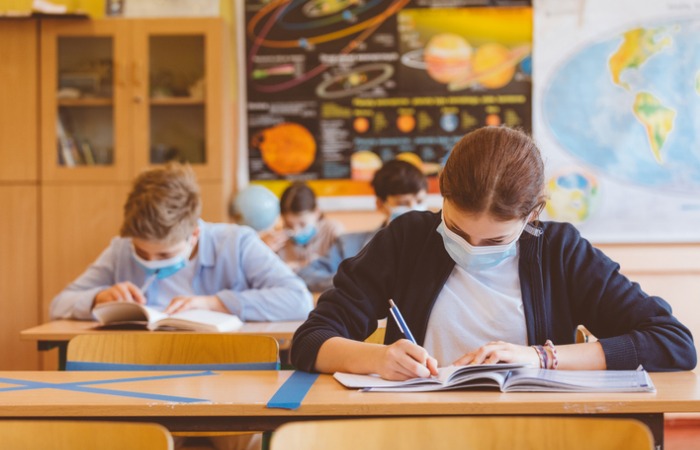
The COVID-19 pandemic is making the 2020 school year a complicated one for students, parents, and educators. Along with being concerned about the disease itself, parents are worried about their children’s emotional responses to the disruptions it brings. But health care experts say there are ways to help kids face these classroom challenges.
In drawing from sometimes conflicting information and guidelines to create a safe school environment, most health care professionals, parents, and educators agree on at least one thing: Children need help adjusting to all the changes. While numerous disruptions can be called “the new normal,” the situation is anything but normal for young children. That’s why it is important to communicate with them, early and often, about their feelings.
Experts in the field of child psychology say that, in times of crisis, children more closely watch the behavior of adults they know. This often means that grownups are to some extent always communicating with children in their care. When teachers, parents, and caregivers deal with matters calmly and openly, they can provide children with the best possible support.
Ellen Eaton, MD, assistant professor of medicine in the UAB Medicine Division of Infectious Diseases, says a good first step for both parents and kids is to accept that the 2020 school year will be an unusual one.
“It’s a good idea to tell your kids to go ahead and expect many changes and disruptions,” Dr. Eaton says. “If we anticipate that there will be sick days, that there will be quarantines, and that there will be frustrations from new rules and classroom structures, then the inconveniences might be more tolerable. A good way to frame that is to explain that their classmates are facing these issues, too. We’re all in this together.”
Staying Calm and Informed
Dr. Eaton suggests that parents can also help kids cope by remaining calm about the virus’ health risks for children.
“The majority of children who have contracted the virus experienced only a mild illness,” Dr. Eaton says. “They are also less likely to contract the virus, because children under the age of 10 have fewer ACE-2 receptors in nasal passages. I’ve heard this receptor called the ‘doorknob’ that COVID-19 turns to enter our systems. Having fewer of those make younger children more resistant to infection. A very small percentage of kids who do get the virus experience severe stages. Most have a common cold type presentation, sometimes with fever.”
Studies show that young children have an immediate emotional response when they see other children or adults arguing. They focus on the energy of the individual instead of the information being discussed. This makes it difficult for young children to understand controversial topics. Extreme claims about COVID-19 that kids may see or hear on television, radio, or online, may worry or frighten them.
Parents can help prevent that by monitoring the amount of screen time that is focused on COVID-19, while sharing information that is appropriate for the age and developmental level of the child. It’s also a good time to explain to older kids that social media is not the best source of news about the pandemic.
Compliance in the Classroom
Dr. Eaton notes that an additional challenge in school setting revolves around compliance with health safety rules. Along with a lack of uniform policies across different school systems, there is the matter of getting students of all ages and even school staff to follow guidelines. Parents and teachers should encourage everyday actions to reduce the spread of germs. Washing hands frequently, wearing masks properly, and remembering to cough or sneeze into a tissue or their elbow can become “gold star” activities.
“We don’t have all the answers with this novel virus, so we learn as we go in terms of planning around it, Dr. Eaton says. “Infectious disease experts believe that school children should wear masks. Staff working with students with special needs, those who require facial cues for communication, for example, can wear a clear mask instead of a cloth mask. We know that the prevention benefit of masks is most effective when both the infected and the uninfected individual are wearing a mask, especially where social distancing is not possible. The class will not reach full benefit of prevention unless all students, teachers, and support staff are always wearing a mask. It’s very hard for kids to comply 100%, because peer pressure and influence start early. My five-year-old is completely compliant when he’s with me, wherever we go. But at school he will start the morning with a mask on, after which I will see pictures from throughout the day with his mask off. That’s because his classmates are not wearing masks.”
Dr. Eaton says the Centers for Disease Control and Prevention (CDC) guidelines that define close contact with someone infected with COVID-19 (six feet or closer for 15 minutes) were designed using data about how the virus is commonly spread between adults. The CDC recommends applying the same rule to the classroom. If anyone in a school setting does meet the close contact criteria, even if asymptomatic, that person should stay home. That also brings new complications for students and staff.
“It’s challenging to know how long to stay quarantined,” Dr. Eaton says. “We believe the time period should be 14 days. In a classroom, you can wind up with multiple quarantine periods, and if you factor in possible ‘household contact’ with family members, or if an infected student has siblings attending that school, it’s clear that we are facing an extremely disruptive school year. That’s why it is so important to first acknowledge that this is not a normal time, and second, to let children know that it’s okay because the grownups are going to help them get through it.”
You ask. Our experts answer. Click here to see UAB Medicine’s COVID-19 FAQ, news, and updates.
